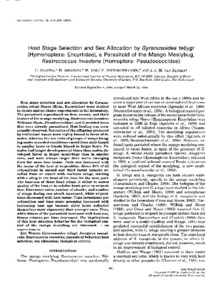| dc.contributor.author | Boavida, C. |
| dc.contributor.author | Ahounou, M. |
| dc.contributor.author | Vos, M. |
| dc.contributor.author | Neuenschwander, P. |
| dc.contributor.author | van Alphen, J.J. |
| dc.date.accessioned | 2019-12-04T11:33:41Z |
| dc.date.available | 2019-12-04T11:33:41Z |
| dc.date.issued | 1995 |
| dc.identifier.citation | Boavida, C., Ahounou, M., Vos, M., Neuenschwander, P. & van Alphen, J.J. (1995). Host stage selection and sex allocation by Gyranusoidea tebygi (Hymenoptera: Encyrtidea), a parasitoid of the mango mealbug, Rastrococcus invadens (Homoptera: Pseudococcidae). Biological Control, 5(4), 487-496. |
| dc.identifier.issn | 1049-9644 |
| dc.identifier.uri | https://hdl.handle.net/20.500.12478/5779 |
| dc.description.abstract | Host stage selection and sex allocation by Gyranusoidea tebygi Noyes (Hym,, Encyrtidae) were studied in choice and no-choice experiments in the laboratory. The parasitoid reproduced on first, second, and third instars of the mango mealybug, Rastrococcus invadens Williams (Hem., Pseudococcidae), and it avoided hosts that were already parasitized. Host feeding was occasionally observed. Sex ratios of the offspring produced by individual wasps were highly biased in favor of females, whereas the sex ratio of groups of wasps foraging under crowded conditions varied from male biased in smaller hosts to female biased in larger hosts. Females had longer developmental times than males, developed faster in larger mealybugs than in smaller ones, and were always larger than males emerging from the same host instar. Their size increased with the instar of the host at oviposition. About 90% of all ovipositions in second and third instar nymphs resulted from an attack with multiple stings, starting with a sting in the head of the host for the most part. The function of these head stings is either to assess quality of the host or to subdue hosts prior to oviposition. Encounter rates, number of attacks, and number of stings during one attack increased, while ovipositions decreased with host instar. Time investment per oviposition and time spent preening increased with increasing host age because older hosts defended themselves more vigorously than younger ones. Thus, while fitness of the parasitoid increased with host size, fitness returns per time decreased. The implications of this host selection behavior for the biological control of the mango mealybug are discussed. |
| dc.language.iso | en |
| dc.subject | Parasitoids |
| dc.subject | Females |
| dc.subject | Mealybugs |
| dc.title | Host stage selection and sex allocation by Gyranusoidea tebygi (Hymenoptera: Encyrtidea), a parasitoid of the mango mealbug, Rastrococcus invadens (Homoptera: Pseudococcidae) |
| dc.type | Journal Article |
| dc.description.version | Peer Review |
| cg.contributor.affiliation | International Institute of Tropical Agriculture |
| cg.contributor.affiliation | Leiden University |
| cg.coverage.region | Africa |
| cg.coverage.region | Acp |
| cg.coverage.region | West Africa |
| cg.coverage.region | Europe |
| cg.coverage.country | Benin |
| cg.coverage.country | Netherlands |
| cg.isijournal | ISI Journal |
| cg.authorship.types | CGIAR and advanced research institute |
| cg.iitasubject | Pests Of Plants |
| cg.iitasubject | Gender |
| cg.iitasubject | Plant Health |
| cg.accessibilitystatus | Limited Access |
| local.dspaceid | 105059 |
| cg.identifier.doi | https://doi.org/10.1006/bcon.1995.1058 |

